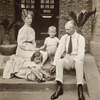A large wooden sculpture group of Guandi on horseback and an attendant, Qing dynasty (1644-1912).
Height 74 cm.
Cracks due to dryness of material, tail and plume missing.
Provenance
From the Collection of Ivan Konsberg, born on September 11th, 1870 in Stockholm. In 1887 he ran away after a falling out with his father and enlisted on a ship bound to Shanghai. He ended up remaining in Shanghai, working for the British Police force until 1903. Subsequently he became a property tax specialist and collector for the Tax Office at Shanghai Municipal Council. He returned for a short visit to Sweden in 1902 whereupon he met his future wife Lillie, who soon joined him out in Shanghai. The couple had three children, James, Beatrice (died at the age of 5 in Shanghai 1912) and Olle. Lillie Konsberg returned to Sweden with the two boys in 1914, since the older son James suffered badly from asthma. Ivan finally left Shanghai and joined his family in Sweden in 1916. The collection was formed between 1890-1916, thence by descent.
More information
It was during the Ming dynasty, that Zhenwu reached the height of his popularity. The third emperor of the Ming dynasty, Yongle (1403-1424), credited Zhenwu for his successful ascension to the throne, declaring that he was under Zhenwu's protection. He ordered numerous temple complexes built in honor of the god at Wudang Shan, the mountain where Zhenwu is believed to have ascended to heaven. His construction projects took 20,000 men twelve years to complete. All subsequent Ming emperors allocated funds for the upkeep of the buildings, and were represented by their favorite eunuchs at religious ceremonies on the mountain. By the middle of the 15th century, Zhenwu had become the most important god in religious Daoism.












































